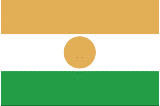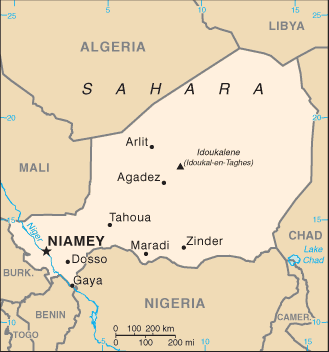|
Niger
|

|
Capital: Niamey
Population: 23,310,715
Brief History of Niger:
The area that is today the country of Niger has been inhabited for thousands of years. Early in history Niger was an important crossroads for trading and was part of many African empires such as the Songhai Empire , Mali , and Bornu.
In recent history Niger has seen large groups of the nomadic Tuareg peoples form confederations. These confederations clashed with the Fulani Empire of Sokoto in the late 18th Century.
The first European explorers to the land were British explorer Mungo Park and German explorer Heinrich Barth in the 1800s. The French showed up later and began to colonize the area. In 1922 Niger became a French colony.
Niger became on independent country in 1960. Since then it has been marred with civil war, poverty, military coups, and famine. It is one of the poorest countries in the world.
The Geography of Niger
Total Size: 1,267,000 square km
Size Comparison: slightly less than twice the size of Texas
Geographical Coordinates: 16 00 N, 8 00 E
World Region or Continent: Africa
General Terrain: predominately desert plains and sand dunes; flat to rolling plains in south; hills in north
Geographical Low Point: Niger River 200 m
Geographical High Point: Mont Bagzane 2,022 m
Climate: desert; mostly hot, dry, dusty; tropical in extreme south
Major cities: NIAMEY (capital) 1.004 million (2009), Zinder
The People of Niger
Type of Government: republic
Languages Spoken: French (official), Hausa, Djerma
Independence: 3 August 1960 (from France)
National Holiday: Republic Day, 18 December (1958)
Nationality: Nigerien(s)
Religions: Muslim 80%, remainder indigenous beliefs and Christian
National Symbol:
National Anthem or Song: La Nigerienne (The Nigerian)
Economy of Niger
Major Industries: uranium mining, cement, brick, soap, textiles, food processing, chemicals, slaughterhouses
Agricultural Products: cowpeas, cotton, peanuts, millet, sorghum, cassava (tapioca), rice; cattle, sheep, goats, camels, donkeys, horses, poultry
Natural Resources: uranium, coal, iron ore, tin, phosphates, gold, molybdenum, gypsum, salt, petroleum
Major Exports: uranium ore, livestock, cowpeas, onions
Major Imports: foodstuffs, machinery, vehicles and parts, petroleum, cereals
Currency: Communaute Financiere Africaine franc (XOF); note - responsible authority is the Central Bank of the
National GDP: $11,630,000,000
** Source for population (2012 est.) and GDP (2011 est.) is CIA World Factbook.
Back to Geography Home Page
